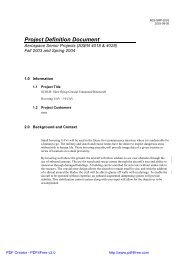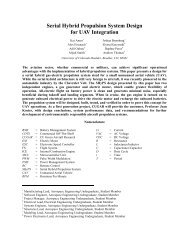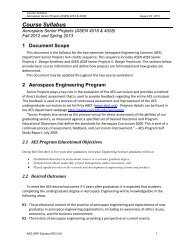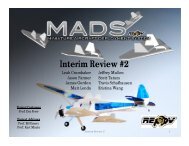PFR - Aerospace Engineering Sciences Senior Design Projects ...
PFR - Aerospace Engineering Sciences Senior Design Projects ...
PFR - Aerospace Engineering Sciences Senior Design Projects ...
You also want an ePaper? Increase the reach of your titles
YUMPU automatically turns print PDFs into web optimized ePapers that Google loves.
Project Final Report – CUDBF April 30 th , 2009<br />
ASEN 4028: <strong>Aerospace</strong> <strong>Senior</strong> <strong>Projects</strong><br />
were drying, balsa mounts, which tightly hold the wingtip hinge systems to the main wing, were<br />
shaped to fit into the tips of the main wings. After the wings were dry, the excess balsa was<br />
removed (to include the balsa sheeting covering the motor mount holes) and the wings sanded<br />
while cavities to house the balsa hinge mounts as well as the wiring, nose gear, and centerline<br />
mount were created. While removing excess glue, the glue that inevitably formed around the<br />
nose gear was removed such that the nose gear can rotate unimpeded. The hinge mounts were<br />
glued into place, the wiring fed throughout the wing halves, and the halves joined with the<br />
centerline mounts and nose gear spar securing the two halves together. After this glue dried, the<br />
excess was removed by sanding. Hollows in the wing were then created to house the batteries<br />
and the receiver as well as the circuit board, which together control the aircraft avionics systems.<br />
After the hollows were created, the wiring was fed to the motor locations and into the main<br />
hatch, and battery cables linked to the battery cavity. Holes were cut into the bottom of the wing<br />
to house the elevator servos, which were mounted onto plywood mounts to secure the servos to<br />
the aircraft. Additionally, cavities were cut to house the main landing gear to the bottom of the<br />
airplane. Holes that match the hinge locations on the elevators were drilled into the trailing edge<br />
of the main wing and the elevators attached. The servos were linked to the elevators and the<br />
system tested to ensure functionality.<br />
12.4 Full System Assembly<br />
Figure 110: Full System Assembly<br />
To complete the aircraft assembly, the wingtip wiring was soldered to the wiring running<br />
through the main wing assembly and the hinges screwed into the balsa hinge mounts. The circuit<br />
board which houses the microcontroller and receiver was connected to the wiring within the<br />
aircraft main hatch. The verticals could then be attached to the wingtips. Small cavities were<br />
shaped in both the wingtip and vertical to house two small L shaped aluminum pieces per<br />
vertical. Glue was then applied to the verticals and wingtips and the verticals attached to the<br />
aircraft. Although the vertical sits nicely atop the wingtip airfoil shape, there remained a section<br />
on the bottom of the aircraft where the vertical sits which required a fairing. A small balsa piece<br />
was shaped and attached to maintain an aerodynamic profile at the bottom of the vertical/wingtip<br />
connection. The main landing gear was then glued to the bottom of the aircraft. Once full<br />
128
















